This wide-angle photo offers the feeling of looking out over the Persian Gulf from an altitude of about 250 miles.
An astronaut aboard the International Space Station captured this highly oblique photograph of the Persian Gulf while in orbit over Saudi Arabia. The Gulf drains into the Indian Ocean through the Strait of Hormuz and forms part of the border for eight countries: Iran, Iraq, Kuwait, Saudi Arabia, Bahrain, Qatar, the United Arab Emirates, and Oman.
Geology and Geography of the Persian Gulf
The Persian Gulf occupies a large depression formed by a tectonic subduction zone between the Arabian and Eurasian plates. The collision of these two tectonic plates also produced the Zagros Mountains in southern Iran, visible to the north-northwest of the Persian Gulf.
The image shows several cities concentrated along the coastline that serve as ports for goods moving in and out of the region. A significant amount of shipping within the Persian Gulf transports oil and petroleum products, with an average of 21 million barrels carried through the Strait of Hormuz each day.
Economic Importance and Earthly Perspective
The photo provides a unique wide-angle perspective of Earth as viewed by astronauts aboard the space station. The 28 millimeter focal length of the camera lens lends a perspective similar to that of the human eye, which has an average focal length of between 22 to 24 millimeters based on the physical refraction of light. In this view, the camera’s focal length and the astronaut’s framing of the image offer the feeling of peering out over the planet from an altitude of about 250 miles (400 kilometers).
Astronaut photograph ISS069-E-92132 was acquired on September 26, 2023, with a Nikon D5 digital camera using a focal length of 28 millimeters. The image was provided by the ISS Crew Earth Observations Facility and the Earth Science and Remote Sensing Unit at Johnson Space Center. The image was taken by a member of the Expedition 69 crew. It has been cropped and enhanced to improve contrast, and lens artifacts have been removed. The International Space Station Program supports the laboratory as part of the ISS National Lab to help astronauts take pictures of Earth that will be of the greatest value to scientists and the public and to make those images freely available on the Internet. Caption by Cadan Cummings, Jacobs, JETS II Contract at NASA-JSC.
Source: scitechdaily









